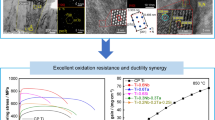Abstract
In this work, the effects of HNO3 concentration on the pit morphologies of high-cubic-texture aluminum foil etched in HNO3–HCl and HNO3–H2SO4–HCl solutions were investigated. When the aluminum foil was etched in HNO3–HCl solutions, the morphologies of pits transformed from irregular tunnels to typical tunnels (as inverted pyramids) and shallow cuboids as the HNO3 concentration in the etchant solution was increased. However, as the HCl concentration in the etchant solution was increased, the morphologies of pits transformed from shallow cuboids to typical tunnels (as inverted pyramids) and irregular tunnels. When the aluminum foil was etched in n N HNO3–(7.2−n) N H2SO4–0.8 N HCl solutions, the morphologies of the pits transformed from typical tunnels (i.e., the number of sub-tunnels formed on the main tunnels increased) to irregular tunnels (corrugated tunnels and polyline tunnels) as the HNO3 concentration in the etchant solution was increased. These effects are attributed primarily to corrosion on the (100) and (010) faces of pits being accelerated and to the (001) faces being prone to passivation to different degrees when various concentrations of HNO3 are added to the etchant solutions.
Similar content being viewed by others
References
L.B. Liang, Y.D. He, H.Z. Song, X.F. Yang, and X.Y. Cai, Effect of placement of aluminum foil on growth of etch tunnels during DC etching, Corros. Sci., 79(2014), p. 21.
C.L. Ban, Y.D. He, X. Shao, and Z.S. Wang, Effects of polymer corrosion inhibitor on widening etch tunnels of aluminum foil for capacitor, Corros. Sci., 78(2014), p. 7.
H.J. Oh, J.H. Lee, H.J. Ahn, Y. Jeong, N.J. Park, S.S. Kim, and C.S. Chi, Etching characteristics of high-purity aluminum in hydrochloric acid solutions, Mater. Sci. Eng. A, 449-451(2007), p. 348.
M. Baumgärtner and H. Kaesche, Aluminum pitting in chloride solutions: morphology and pit growth kinetics, Corros. Sci., 31(1990), p. 231.
C.L. Ban and Y.D. He, Controlling limiting length of tunnels on Al foil electroetched in HCl–H2SO4 solution, Trans. Nonferrous Met. Soc. China, 19(2009), No. 3, p. 601.
J.K. Lee, J.Y. Kim, J.T. Kim, J.H. Lee, H.Y. Chung, and Y.S. Tak, Effects of pretreatment on the aluminum etch pit formation, Corros. Sci., 51(2009), No. 7, p. 1501.
E.E. Abd El Aal, S. Abd El Wanees, A. Farouk, and S.M. Abd El Haleem, Factors affecting the corrosion behaviour of aluminium in acid solutions: II. Inorganic additives as corrosion inhibitors for Al in HCl solutions, Corros. Sci., 68(2013), p. 14.
S. Wernick, R. Pinner, and P.G. Sheasby, The Surface Treatment and Finishing of Aluminum and Its Alloys, 5th Ed., ASM international, Spain, 1987, p. 190.
E. McCafferty, Sequence of steps in the pitting of aluminum by chloride ions, Corros. Sci., 45(2003), No. 7, p. 1421.
E. McCafferty, The electrode kinetics of pit initiation on aluminum, Corros. Sci., 37(1995), No. 3, p. 481.
R.S. Alwitt, H. Uchi, T.R. Beck, and R.C. Alkire, Electrochemical tunnel etching of aluminum, J. Electrochem. Soc., 131(1984), No. 1, p. 13.
K.R. Hebert, A mathematical model for the growth of aluminum etch tunnels, J. Electrochem. Soc., 148(2001), No. 6, p. B236.
H. Zuo and W.M. Mao, Influence of micro-alloyed Pb and chromate on the corrosion behavior of high voltage anode aluminum foil, J. Mater. Sci. Eng., 23(2005), No. 4, p. 604.
A. Hibino, M. Tamaki, Y.K. Watanabe, and T. Oki, The effect of sulfuric acid on tunnel etching of aluminum in hydrochloric acid, J. Jpn. Inst. Light Met., 42(1992), No.8, p. 440.
K.H. Na and S.I. Pyun, Effects of sulphate, nitrate and phosphate on pit initiation of pure aluminium in HCl-based solution, Corros. Sci., 49(2007), No. 6, p. 2663.
S.I. Pyun and S.M. Moon, The inhibition mechanism of pitting corrosion of pure aluminum by nitrate and sulfate ions in neutral chloride solution, J. Solid State Electrochem., 3(1999), No. 6, p. 331.
Author information
Authors and Affiliations
Corresponding author
Rights and permissions
About this article
Cite this article
Yi, Qx., He, Yd., Peng, N. et al. Effects of HNO3 concentration on the pit morphologies of aluminum foil etched in HNO3–HCl and HNO3–H2SO4–HCl solutions. Int J Miner Metall Mater 23, 70–76 (2016). https://doi.org/10.1007/s12613-016-1212-5
Received:
Revised:
Accepted:
Published:
Issue Date:
DOI: https://doi.org/10.1007/s12613-016-1212-5




